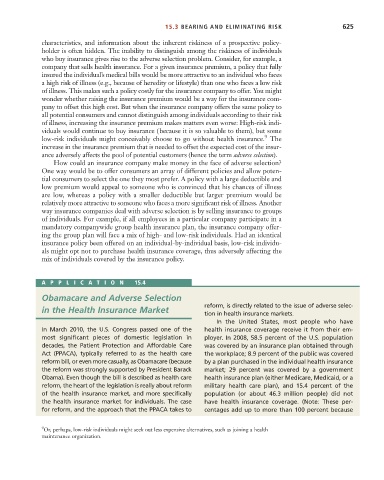Page 651 - Microeconomics, Fourth Edition
P. 651
c15riskandinformation.qxd 8/16/10 11:10 AM Page 625
15.3 BEARING AND ELIMINATING RISK 625
characteristics, and information about the inherent riskiness of a prospective policy-
holder is often hidden. The inability to distinguish among the riskiness of individuals
who buy insurance gives rise to the adverse selection problem. Consider, for example, a
company that sells health insurance. For a given insurance premium, a policy that fully
insured the individual’s medical bills would be more attractive to an individual who faces
a high risk of illness (e.g., because of heredity or lifestyle) than one who faces a low risk
of illness. This makes such a policy costly for the insurance company to offer. You might
wonder whether raising the insurance premium would be a way for the insurance com-
pany to offset this high cost. But when the insurance company offers the same policy to
all potential consumers and cannot distinguish among individuals according to their risk
of illness, increasing the insurance premium makes matters even worse: High-risk indi-
viduals would continue to buy insurance (because it is so valuable to them), but some
9
low-risk individuals might conceivably choose to go without health insurance. The
increase in the insurance premium that is needed to offset the expected cost of the insur-
ance adversely affects the pool of potential customers (hence the term adverse selection).
How could an insurance company make money in the face of adverse selection?
One way would be to offer consumers an array of different policies and allow poten-
tial consumers to select the one they most prefer. A policy with a large deductible and
low premium would appeal to someone who is convinced that his chances of illness
are low, whereas a policy with a smaller deductible but larger premium would be
relatively more attractive to someone who faces a more significant risk of illness. Another
way insurance companies deal with adverse selection is by selling insurance to groups
of individuals. For example, if all employees in a particular company participate in a
mandatory companywide group health insurance plan, the insurance company offer-
ing the group plan will face a mix of high- and low-risk individuals. Had an identical
insurance policy been offered on an individual-by-individual basis, low-risk individu-
als might opt not to purchase health insurance coverage, thus adversely affecting the
mix of individuals covered by the insurance policy.
APPLICA TION 15.4
Obamacare and Adverse Selection
reform, is directly related to the issue of adverse selec-
in the Health Insurance Market
tion in health insurance markets.
In the United States, most people who have
In March 2010, the U.S. Congress passed one of the health insurance coverage receive it from their em-
most significant pieces of domestic legislation in ployer. In 2008, 58.5 percent of the U.S. population
decades, the Patient Protection and Affordable Care was covered by an insurance plan obtained through
Act (PPACA), typically referred to as the health care the workplace; 8.9 percent of the public was covered
reform bill, or even more casually, as Obamacare (because by a plan purchased in the individual health insurance
the reform was strongly supported by President Barack market; 29 percent was covered by a government
Obama). Even though the bill is described as health care health insurance plan (either Medicare, Medicaid, or a
reform, the heart of the legislation is really about reform military health care plan), and 15.4 percent of the
of the health insurance market, and more specifically population (or about 46.3 million people) did not
the health insurance market for individuals. The case have health insurance coverage. (Note: These per-
for reform, and the approach that the PPACA takes to centages add up to more than 100 percent because
9 Or, perhaps, low-risk individuals might seek out less expensive alternatives, such as joining a health
maintenance organization.

